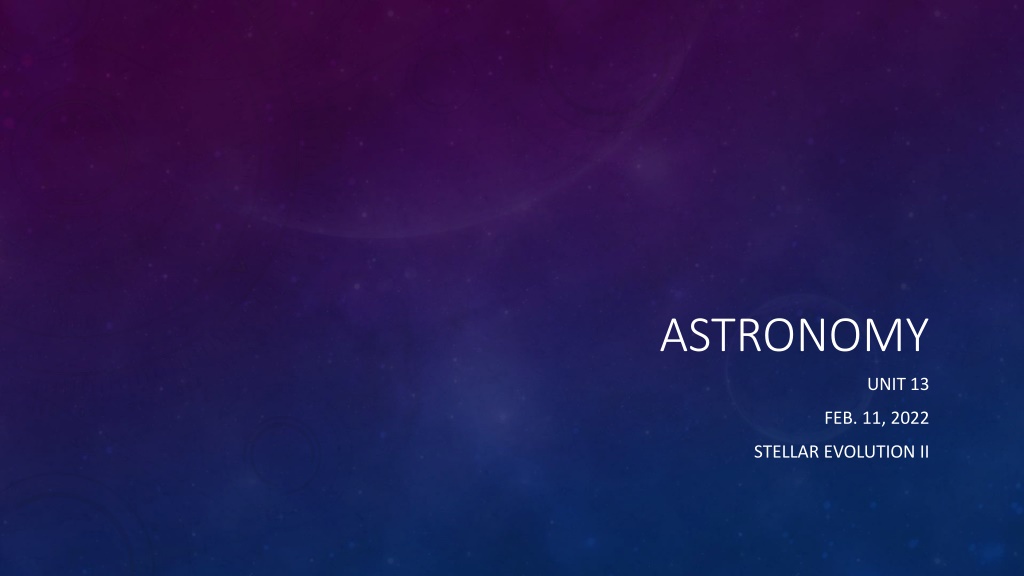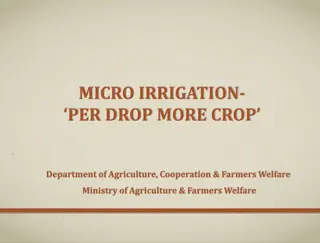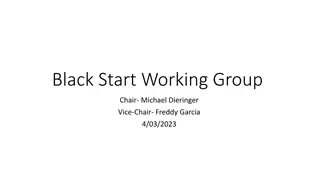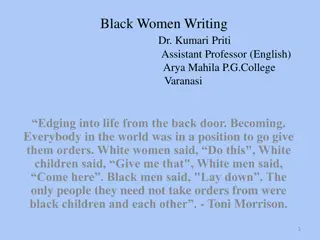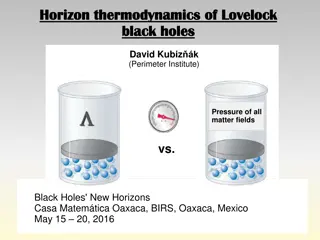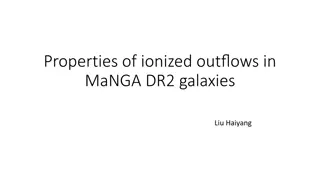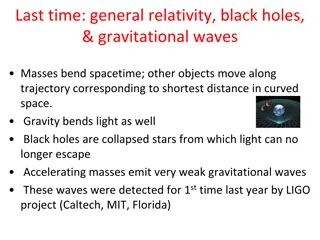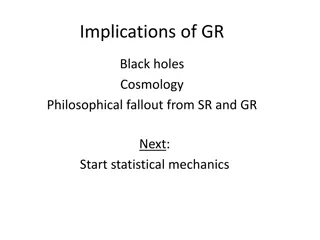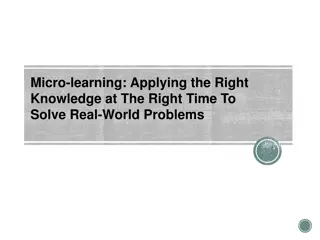Journey Through Black Holes: From Micro to Supermassive
Explore the fascinating world of black holes, from theoretical micro black holes that emit Hawking Radiation to stellar black holes formed from high-mass star collapses. Discover intermediate and rogue black holes, as well as the mysterious supermassive black holes found at the centers of galaxies. Delve into upcoming events like star parties and uncover the enigmatic nature of these cosmic giants.
Download Presentation

Please find below an Image/Link to download the presentation.
The content on the website is provided AS IS for your information and personal use only. It may not be sold, licensed, or shared on other websites without obtaining consent from the author. Download presentation by click this link. If you encounter any issues during the download, it is possible that the publisher has removed the file from their server.
E N D
Presentation Transcript
ASTRONOMY UNIT 13 FEB. 11, 2022 STELLAR EVOLUTION II
UPCOMING EVENTS Science Board What is your topic? March 4 Star Party Dungeness Recreational Area, Sequim Orion Nebula, Betelgeuse, Rigel, Sirius and Antares
OVERVIEW MBH IMBH SBH SMBH UMBH
THEORETICAL MICRO BLACK HOLE To make a black hole, one must concentrate mass or energy sufficiently that the escape velocity from the region in which it is concentrated exceeds the speed of light. While theoretically possible, these phenomenon would evaporate very quickly due to Hawking Radiation. According to Hawking Radiation black holes emit some particles. Emission rate increases as size of BH decreases. A MBH would evaporate very quickly MBHs would have a mass of less than the moon and be microscopic. They have not yet been observed or created. Tevatron at Fermi National Accelerator Laboratory, Batavia, Illinois
TDE J2150 Intermediate black holes, IMBHs are between 300 and 5000 solar masses in size. They are uncommon and difficult to detect. TDE J2150 was detected when a strong burst of X-rays were emitted from J2150 s location. J2150 is a star that got too close to its companion black hole. The encounter triggered a massive disruption of the IMBH s accretion disk resulting in a huge x-ray burst. Location of TDE 3XMM J215022.4- 055108
ROGUE BLACK HOLE By combining Hubble observations with ground telescope data, scientists discovered a 270-day-long microlensing event, called MOA-2011-BLG-191/OGLE-2011-BLG-0462, which they said likely came from an isolated black hole. Typically, black holes have only been discovered due to their influence on another object Size of this object has not been determined, likely it is an IMBH
STELLAR BLACK HOLES Formed when a high mass star undergoes core collapse Most SBHs are found in binary systems When pulling material from the companion, the SBH creates an accretion disk of fast moving material Energy in the disk creates so much radiation up to x-rays, Cygnus X-1 was discovered through high emissions of X-rays. HDE 226868 Cygnus X-1
SUPERMASSIVE BLACK HOLE The mechanism for the creation of SMBHs is unknown. One theory is that are created with two smaller black holes collide. Most known SMBHs are in the center of galaxies such as M87 at right. Accretion disks are much larger than for SBH and form large jets of material and energy The M87 SMBH is 6.5 billion solar masses The X-ray jet at right is more than 1,000 light years long. SMBH center of M87 Galaxy
SAGGITARIUS A* Saggitarius A* is the name of the SMBH in the center of our galaxy Initially detected as a strong radio source in 1931 In 2002 a star, S2 was detected orbiting the radio source. By evaluating the mathematics of the S2 s orbit, the mass of Saggitarius A* was determined to be about 4 million solar masses in a space of 120 AU which is 3 times larger than Pluto s orbit S2 is the fastest observed object, travelling at peak speeds of 11,000,000 mph on it s closest approach to the black hole. SMBH center of Milky Way Galaxy
ULTRAMASSIVE BLACK HOLE 18 billion light years away at a luminosity of 140 trillion times the sun lies TON 618. At 64 billion solar masses it has more mass than all the stars in the Milky Way Infalling gas at the event horizon is estimated to be 7,000 KM/sec, faster than S2 s orbit around Saggitarius A* Detected by high radio emissions, the formation mechanism for TON 618 is unknown.
SN 2020TLF 1. Dramatic luminosity fluctuations in this star were detected in the summer of 2020 2. For 130 days the star began shedding vast amounts of stellar material, unusual for this type of star. 3. At the end of the 130 days, luminosity spiked again in a series of flares 4. Following this violent activity, the core collapsed resulting in a supernova explosion 5. The unique aspects of this event are 1. Pre explosion state was observed 2. Luminosity fluctuations SN 2020TLF in the galaxy NGC 5731
NASA UPDATE JWST First light: HD84406 Aligning mirrors Blog [link] Artemis April earliest launch
INTERNET RESOURCES https://viewspace.org/interactives/unveiling_invisible_universe Clear Dark Sky website Star Walk SOHO Viewer Google Sky website Astronomy Picture of the Day website Astronomy specifically The Sky this Month article NASA Solar System simulator Surface Gravity Calculator Wolfram Alpha Comet Leonard
